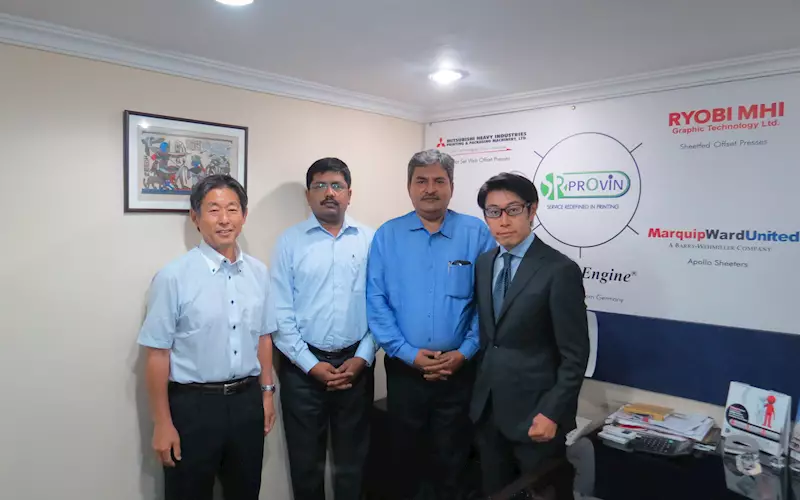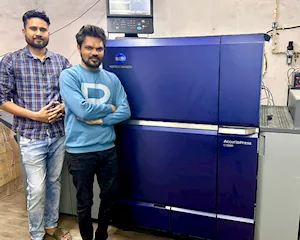Looking at 2015: Ryobi-Mitsubishi to boost customer confidence
What can customers expect after the merger between Ryobi and Mitsubishi, which was sealed on 1 January, 2014? We promise to advance with our customers, says Yuzuru Ichimasa, senior vice-president, Ryobi MHI Graphic Technology, the new company that came into being after the joint venture. Ichimasa, along with Shinya Taguchi, group leader, international sales, Ryobi MHI, and Vinay Kaushal, director, Provin Technos, talk to Rahul Kumar of PrintWeek India about the road ahead in 2015
24 Dec 2014 | By Rahul Kumar
 We set up a joint venture company in January this year, says Ichimasa, and the market is more than expectant to see us grow. “People from different companies and different cultures have come together at Ryobi MHI. It is a good combination,” he adds. And, this shows in the company hierarchy.
We set up a joint venture company in January this year, says Ichimasa, and the market is more than expectant to see us grow. “People from different companies and different cultures have come together at Ryobi MHI. It is a good combination,” he adds. And, this shows in the company hierarchy.“Business is good, more than we had expected. Now, we are trying to expand our production capacity, as the business has exceeded our expectations,” he says.
Right now, the market share of Ryobi MHI, according to Ichimasa, is not yet 10%, but more than 5%. “We are trying to convert it into double digit number,” he says.
Before the joint venture, Ryobi was known for smaller size and format, while Mitsubishi used to deal in large-format machines. Post the joint venture, Ryobi MHI is supplying the products from both the companies, 20 different models in total. Now, the plan is to fill the vacuum in the mid-sized machine segment, says Ichimasa. The other priority is product development. “Ryobi explored what was missing and tried to apply new technology to print. On the other hand, Mitsubishi concentrated on the press itself, to improve its efficiency. By combining these two aspects, we could enhance our development technology,” Ichimasa says.
Ryobi factory in Hiroshima
He says Mitsubishi already had production units. To improve production and size-wise capacity, Ryobi MHI has set up a factory in Hiroshima dedicated to printing press manufacturing, for which the existing Mitsubishi expertise has been utilised. “Also, both the companies had separate sales facilities and after-sale services. By combining them into one, we could expand our customer base. That is why we could do better than expected,” he says.
As the company is doing better, it is also increasing its production capacity. “We have increased our capacity by 20%. We plan to double it soon," he says, adding that "according to estimates, the company sells around 250 machines per year the world over." Now, it wants to take the number to 350.
“The reaction from the printing fraternity has been positive after the joint venture,” Ichimasa says. “We are a good combination. The sales figures of Ryobi and Mitsubishi were the same. Now, the size of sales has doubled. This shows that the company has the potential to grow. This will create confidence among new customers,” Ichimasa said. In this context, In India, Delhi-based Provin Technos has been appointed as the pan-India representative of Ryobi MHI.
While Ryobi MHI is already bridging the size gap of machines, according to Ichimasa, Ryobi machines are unique. “We have machines with casting and forging system, holographic coating, and folding in a single unit,” says Ichimasa. “Mitsubishi used to create basic sheetfed functions. These two companies are now working together. Those engineers who worked on those machines are now working together. I cannot tell you what we are developing right now, but I can tell you that we, as well as our customers, have great expectations.”
Upbeat about UV LED in India
He, however, is forthcoming about the UV LED printing presses being developed by Ryobi MHI, which he says, is an accomplished technology and is ready to be used in the market. “But it needs improvements. The machines are there, but ink suppliers should be ready in each market. I think they are ready in the Indian market and we have good expectations from India. In Japan, printers have already shifted from conventional UV to LED UV. The future is LED UV.”
Vinay Kaushal, director, Provin Technos, is also upbeat about LED UV market in India subsequent to recent developments introduced by Ryobi MHI and expects approximately 12 LED UV installations in India by the end of 2015.
Gradual growth in India
All the three offset printing press manufacturers from Germany declared profit from the Indian market in the last financial year. So did the Japanese manufacturers. In this context, what kind of future does Ryobi MHI see for itself in India? “The Indian printing industry is growing gradually. It is a good time for us to start the joint venture and return to the market,” Ichimasa says. “We will continue to sell the former Ryobi machines. We would also like to start marketing for the larger machines. The timing is good. Indian economy is recovering; we would like to utilise the timing.”
Ichimasa says any kind of marketing will happen only with the cooperation of the customers. “We have specialists in sheetfed press sales,” Ichimasa said, pointing towards Kaushal. “We have been in the market for the past two years, offering after-sales services, Kaushal says. “With the introduction of the range, now is the time to enter the market. We are approaching it from multiple fronts.”
Kaushal says while the Indian representative of Ryobi MHI has been upgrading the machines of the existing customers, it is also approaching new ones. “We are educating them at multiple levels, that too in an ethical way. We have already sold five machines,” he says.
Looking at packaging
The Indian print industry is a growing sector with different segments, such as commercial printing, packaging, publication and so on. Which of these markets Ryobi MHI is keen on exploring? “We are definitely looking at packaging. However, we should have more number of unit sales in commercial printing,” Ichimasa says. He says the market for commercial printing is slightly on the decline. At the same time, packaging is the future. “We are already in commercial printing. Now, we would like to enter into packing in a big way,” he says.
Since the formation of the new government at the centre, there has been a flutter in the industry that the market is improving. The vibe is positive, says Kaushal. Ichimasa adds that people in Japan are expecting good things from the new Indian government in terms of new policies. “I think the new government is very friendly with Japan as a nation, which is encouraging,” he says.
Why Ryobi MHI?
Now, PrintWeek asks a question worth a million yen. Why should a printer invest in Ryobi MHI? “We have the Ryobi machine advantage,” says Ichimasa. We will need to educate the customers and convince them. They are our investment.” Kaushal says one of the greatest advantages is the low cost of ownership. The other is reliable technical support. “I don’t want to sound blunt, but our machines are technically at par and innovative to the German machines, and yet very, very competitive.” He says the company provides technical background support for each and every machine and shares the details with the customer.
The peculiarity of the Indian market is that almost 85% of all the machines used are pre-owned. How does Ryobi MHI plan to tackle the competition of second-hand machines? “It’s a difficult situation. The printers are forced to buy second-hand machines because their budget is limited. As long as they are satisfied with our second-hand machines, naturally, they will be inclined to buy our new machines. The same goes with other companies as well. Nevertheless, we will have to cater to the owner of our second-hand machines. We never refuse after-sale service to pre-owned machine owners,” Ichimasa says.
Many printing press manufacturing companies offer financial help to a printer who wants to invest in a new machine. Ryobi MHI does not have any such plans, but Ichimasa says the company can help a printer who wants to buy a new machine and would like to sell the old one.
20-25% market share soon
About the Indian market, right now, Ryobi MHI would like to improve its market share in the sheetfed business,” Ichimasa says. Kaushal adds that in the financial year 2014-2015, the company is eyeing a market share of 20-25% in India.
Are there new technologies in the pipeline? To be frank, Kaushal says, Ryobi MHI has enough innovative technologies. People just have to pick them up.
Ichimasa is more forthcoming. “In the future, we will have to be ready with digital presses,” he says. “One will be of inkjet type and the other will be of toner type. We also want to utilise our technology for the regular offset sheetfed press, and we are on our way.”
Finally, Ichimasa confides that Indian printing industry is very important to Ryobi MHI. “And personally, I am fond of India. So, I would like to be successful here,” he adds.
|
List of five customers 1 - Bijal Arts in Surat has commissioned a four colour with coater and model - 924 D 2 – Mumbai-based, Selection De Scan has bought a four colour with coater and model - 924 D 3 - Hira Prints in Mumbai has invested in a four colour with coater and model - 684 4 – New Delhi–based, Samrat Offset Printers has opted for a four colour with coater and model - 924 D 5 – Bengaluru – based Dinesh Printers has ordered a five colour with coater and model - 925 D |
|
Ryobi MHI: Twice as Big Since the merger between Ryobi Limited Graphic Systems Division and Mitsubishi Heavy Industries Print & Packaging Machinery, the new company is now trading as Ryobi MHI Graphic Technology, offering a full range of sheetfed offset presses. Both the companies were founded in 1943. The press ranges of the two companies make a good fit. Ryobi brings a wide range of medium- and small-format printing presses and a sales network that stretches across Europe, the Americas, and the rest of the world. Mitsubishi Heavy Industries Printing & Packaging Machinery brings a diverse customer base that includes major printing companies for large-format presses in Japan and in other regions around the world, particularly in Asia. The presses supplied by the new company include all 20 existing machines, ranging from single colour A3 up to multi-colour, 1,120mm x 820mm sizes. According to Ryobi, the joint venture was an effort to bolster competitiveness, boost scale of operations and product line-up, cut costs, and improve sales and service networks. The company cited market conditions and shrinking demand, especially in developed countries, as the main thrust behind the partnership. |
|
Company Profile Name: Ryobi MHI Graphic Technology Head Office: 800-2 Ukai-cho, Fuchu-shi, Hiroshima-ken, Japan Scope of Business: Manufacture and sale of printing equipment and related products Capitalisation: 100 million yen (capitalisation 100 million yen + capital reserve 7,900 million yen: total 8,000 million yen) Ownership: Ryobi: 60%; Mitsubishi Heavy Industries Printing & Packaging Machinery: 40% Established: 1 January, 2014 (Source: ryobi-group.co.jp) |














 See All
See All